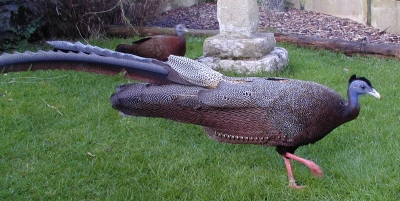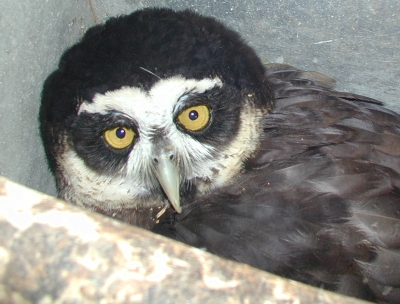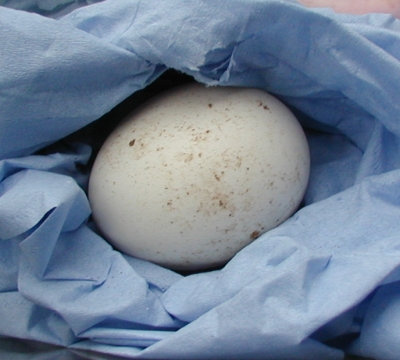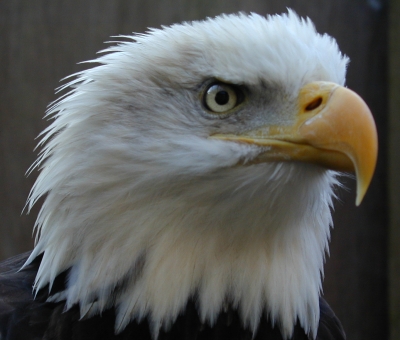After the rigours of winter it is always amazing when the first signs of spring arrive. This really is one of the best times of the year to be fortunate enough to have a job working with living creatures. The whole park is buzzing with activity. Whether it's setting up nest boxes, refurbishing enclosures, planning for the seasons presentations or tending eggs as they develop in an incubator all the keeping staff are in top gear as the new season is approaching.
There are many species already well into breeding mode, almost certainly as a result of the unusually mild weather. Two pairs of Humboldt Penguin currently have a chick apiece and at least two other pairs are incubating. Alexandrine Parakeets, Swainson’s Lorikeets and Gouldian Finches also all have chicks at varying stages of development, and within our incubation room we have two fertile eggs from one of our pairs of Argus Pheasant and five tortoise eggs. Of course we would always prefer natural incubation by the parents but there are some species such as the Argus Pheasant from which we pull clutches to incubate artificially in order to maximise the numbers reared in a single season. It is not without risk. Incubation is only part of the process, a successful hatch and a trouble free rearing are still hurdles to cross before you have an independent young bird. I don’t consider a bird successfully reared until it has chicks of its own!

Pair of Argus Pheasant
Incubating their own eggs as I write are a pair of Rothschild’s Grackle (more commonly now known as Bali Starlings) that have laid the first two eggs of their clutch, and a pair of Spectacled Owls. The owls however, have never successfully hatched an egg despite producing fertile eggs most seasons. For that reason we will remove at least one of their eggs, once the parents have sat for ten days or so, in order to try and hatch it in an incubator.

Incubating Spectacled Owl

Spectacled Owl Egg

“Archie” the Bald Eagle
Archie the Bald Eagle has been moved from his winter quarters and placed in the weathering from where we can start to fly him once again in preparation for the start of the Free Flight presentations. No sooner was Archie moved from his winter quarters than the enclosure was stripped and refurbished to accommodate one of our pairs of Chough. We now have three pairs of these beautiful symbols of Cornwall set up for breeding, each with a camera in the nest so we can monitor their activity without undue disturbance.
There have been many bird movements in the last three weeks, some were simply the moving on of young birds to other collections but many were to establish new pairs here or elsewhere. The young Hunting Cissa that we bred in 2006 are now enjoying a new home at Thrigby Hall http://www.thrigby.plus.com/ and the three young Von der Decken’s Hornbills have now gone to Harewood Bird Garden (1.1) and Bristol Zoo (1.0). Becky and I had a long day on Tuesday, which started at 4.30am. We drove to Waddesdon Manor Aviaries, a private collection and then on to Bristol Zoo, finally arriving back at the park at 9.30pm. A long day but well worth it. We had a guided tour of the aviaries at Waddesdon by Andrew and we were most impressed. Although not a large collection, it is extremely well maintained and a real gem in the world of aviculture, and the setting is just superb. If you get the chance, do visit. http://www.waddesdon.org.uk/contact.html
We collected a female White Crested Touraco from Waddesdon to join our single male. John and Peter from Harewood Bird Garden http://www.harewood.org/ drove to Waddesdon to meet us, they too left home at 4.30 am, and we literally drove into Waddesdon together, good timing! They collected from us the two Von der Decken’s Hornbills and a female Luzon Bleeding Heart Pigeon which we exchanged with them for a male – Harewood had a surplus of males and we had only three females, now we both have the potential to breed this species this year.
After leaving Waddesdon Becky and I drove to a private collection where we were made most welcome, and where we spent over an hour talking birds. Two of our young Violaceous Touracos are now at this collection together with some young Hahn’s Macaws and Crimson Winged Parakeets. We came away with four very nice Yellow Rosellas.
We then drove on down to Bristol Zoo http://www.bristolzoo.org.uk/ after a brief detour in Droitwich Spa trying to find a garage…but that’s another story!
At Bristol we met Nigel just before the Zoo closed for the night. Nigel showed us around the Wallace Aviary which is just brimming with wonderful birds – Victoria Crowned Pigeons, Nicobar Pigeons, Roul roul Partridges, the list goes on and on. Again, if you like birds, pay it a visit. We had a young male Von der Decken’s Hornbill and a female Spreo Starling for Nigel and collected a male Spreo Starling and a beautiful group of young Black Cheeked Lovebirds. Then it was homeward bound.
As I write Perry is on his way to Paignton Zoo http://www.paigntonzoo.org.uk/HTML/index.asp this morning to rendezvous with Lisa from Paulton’s Park. http://www.paultonspark.co.uk/
He is collecting a pair of Greater Necklaced Laughing Thrushes and a young Tawny Frogmouth from her.
As you can see this is a busy time of the year, but there’s always more excitement to come………..
































